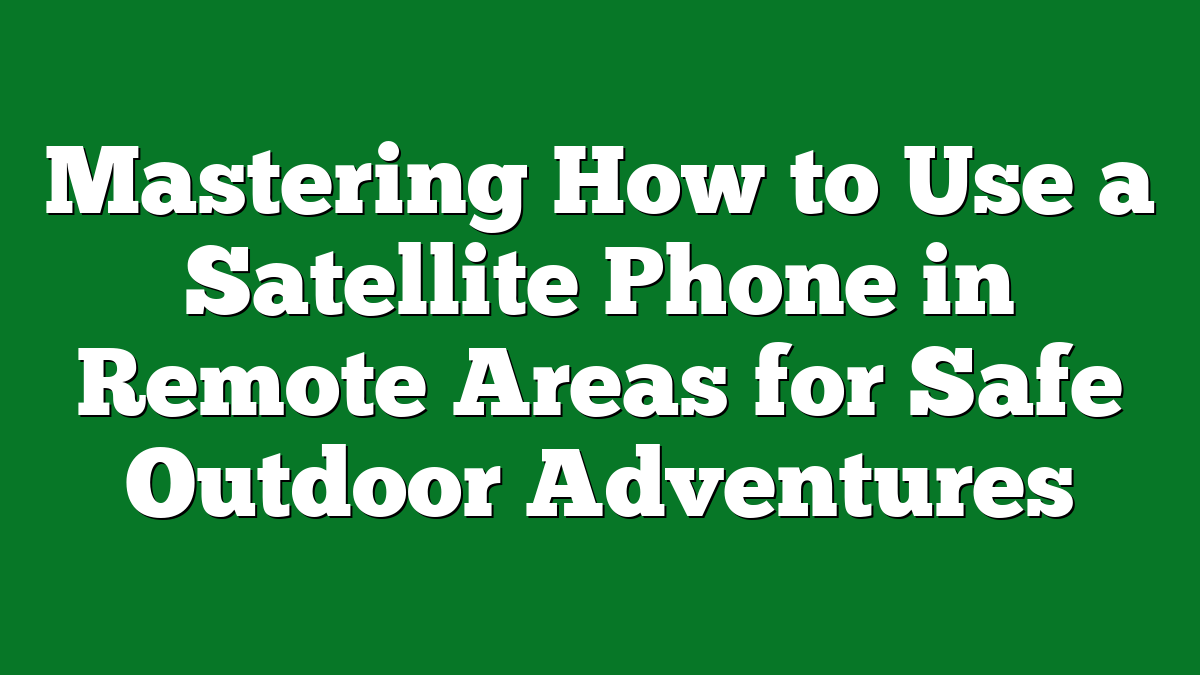When you find yourself in the great outdoors, far from civilization, staying connected can be a challenge. That’s where satellite phones come in. These devices are lifesavers, allowing you to communicate even in the most remote areas. I’ve learned a lot about using them effectively, and I’m excited to share some tips that can make your experience smoother.
Whether you’re hiking in the mountains or exploring uncharted territories, knowing how to use a satellite phone is crucial. It’s not just about making calls; it’s about ensuring your safety and staying in touch with loved ones. Let’s dive into the essentials of using a satellite phone, so you can venture off the beaten path with confidence.
Understanding Satellite Phones
As an avid camper, I recognize the critical role satellite phones play in maintaining communication during my outdoor adventures. These devices ensure I stay connected, even when far from civilization.
What Is a Satellite Phone?
A satellite phone is a communication device that uses satellites orbiting the Earth to send and receive calls and messages. Unlike traditional cell phones, which rely on ground-based towers, satellite phones work in remote areas where conventional signals lack coverage. Various brands, like Iridium and Globalstar, offer models specifically designed for outdoor enthusiasts, providing reliable connectivity wherever I roam.
How Does It Work?
Satellite phones connect to orbiting satellites instead of ground stations. When I make a call or send a message, my device transmits the signal to a satellite, which relays it back to a ground station. After that, the ground station connects to the recipient’s phone, whether it’s another satellite phone or a regular mobile phone. This system allows for communication across vast distances and even in the most isolated environments, ensuring that I’m reachable during my hiking, hunting, and fishing trips.
Preparing for Your Trip
Preparing for a trip into the wilderness involves careful planning, especially when it comes to communication. A satellite phone can be a lifeline in remote areas. Having the right tools and gear makes all the difference in ensuring a smooth adventure.
Choosing the Right Satellite Phone
Selecting the right satellite phone starts with understanding coverage and functionality. I prefer models from Iridium or Globalstar, known for their reliable connections in isolated spots. Consider the specific features that matter most to you, like battery life, durability, and whether you need data capabilities in addition to voice calls. Some phones also allow for text messaging, which can be a great way to communicate without making calls. Evaluate your needs and pick a model that fits your adventure’s demands.
Essential Accessories to Bring
Bringing the right accessories enhances your satellite phone experience. Pack a car charger to ensure you can recharge on the go, especially during long trips when you’re off the grid. A portable solar charger is a great backup, too. Another useful accessory is a protective case; it shields the device from impacts and weather conditions. Additionally, don’t forget extra batteries if your model allows for it. I always keep a small toolkit handy for any minor repairs. These accessories can help maintain connectivity and preserve your phone’s longevity in the wild.
Setting Up Your Satellite Phone
Setting up your satellite phone properly is crucial for reliable communication in remote areas. Take the time to follow these steps to ensure the device functions optimally during your outdoor adventures.
Charging and Powering the Device
Charging your satellite phone before heading into the wild is essential. Check that the battery is fully charged, as many models can last over 24 hours with moderate use. Consider bringing a portable solar charger or a car charger for longer trips, allowing for continuous power even away from traditional outlets. I often carry a backup battery, ensuring I’m never without a way to keep my device running, especially during extended excursions.
Inserting SIM Cards and Making Connections
Inserting the SIM card into your satellite phone is straightforward. Start by locating the SIM card slot, usually found under the battery or back cover. Handle the card carefully, ensuring the metal contacts face the correct way. After inserting the card, power the device on and wait for a signal. Satellite phones may take a few moments to connect, especially in dense wooded areas or valleys. For best results, step outside into an open area with a clear view of the sky. I’ll often check in with family or fellow campers shortly after activating the phone—this practice helps me confirm everything is working before heading deeper into the wilderness.
Using the Satellite Phone
Using a satellite phone in remote areas keeps me connected during my camping adventures. The simplicity of using these devices ensures I can stay in touch with loved ones or emergency services no matter where I am.
Making Calls in Remote Areas
Making calls requires clear instructions for success. First, ensure the phone is powered on and fully charged. Pick an open area away from tall trees or buildings to establish a stronger connection. I often extend my arm to position the phone for better reception. Dial the number as you would with a regular phone. Some satellite networks require entering country codes, especially if calling internationally. If I encounter issues, I wait a moment before redialing, allowing the system to refresh its connection.
Sending Text Messages and Data
Sending text messages can be just as crucial. The process is straightforward but differs slightly from voice calls. I navigate to the messaging feature on my satellite phone. It’s important to watch character limits, as most models restrict messages to a specific number of characters. I send the message by entering the recipient’s phone number or selecting them from my contact list, if the phone supports it. For data, I ensure I’m aware of my satellite phone’s data plan and usage, keeping the messages concise to avoid exceeding limits. Staying mindful of these details helps ensure my communication remains clear and effective in the wild.
Troubleshooting Common Issues
Using a satellite phone can be straightforward, but sometimes issues arise, especially in remote areas. Here are some common problems and how to tackle them.
Connectivity Problems
Connectivity problems often occur due to environmental factors. To enhance signal reception, I always find an open area away from obstacles like trees or mountains. If you’re experiencing dropped calls or no signal, check that the device’s antenna is fully extended and pointed towards the satellite. If problems persist, turn the phone off, wait a moment, and then power it back on. Restarting the device usually helps re-establish a connection. I’ve also learned that keeping your satellite phone updated with the latest firmware can improve connectivity, so it’s good practice to check for updates before heading out on a trip.
Battery Life Concerns
Battery life is crucial for satellite phone functionality, especially in the wilderness. I always keep my phone fully charged before any adventure. On longer trips, I pack a portable solar charger or extra batteries to avoid running out of power. If battery life starts to dwindle during a trip, I minimize usage by turning off features like Bluetooth and disabling non-essential applications to conserve energy. Regularly checking the battery status during your travels helps ensure you’re not caught off guard. Carrying a charging cable suited for your satellite phone model is essential, especially if you plan to be in the backcountry for an extended period.
Conclusion
Using a satellite phone in remote areas can truly transform your outdoor adventures. It’s not just about staying connected; it’s about peace of mind knowing you can reach out for help or share your experiences with loved ones.
With the right preparation and knowledge, you can navigate the challenges of remote communication effortlessly. Whether it’s picking the best device or troubleshooting connectivity issues, being equipped with the right tools makes all the difference.
So as you plan your next trip into the wild, don’t forget to include a satellite phone in your gear. It could be your lifeline and a way to keep those cherished connections alive, no matter how far you roam. Happy adventuring!











